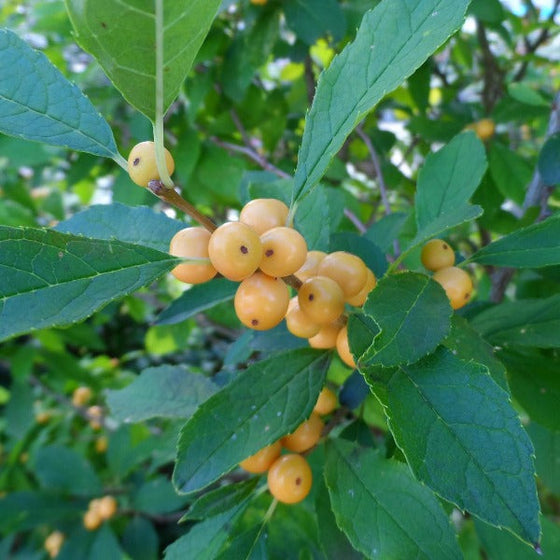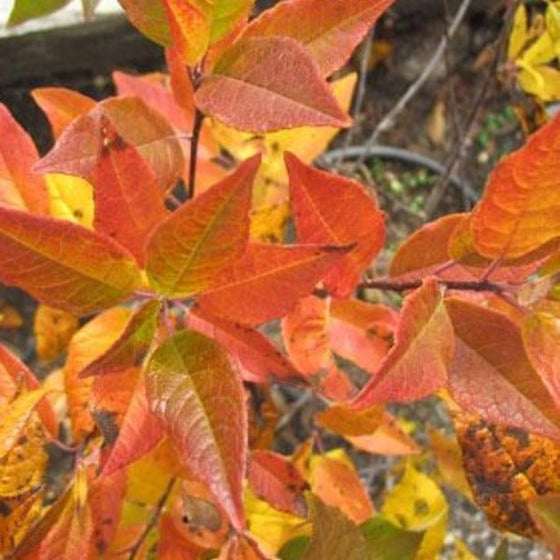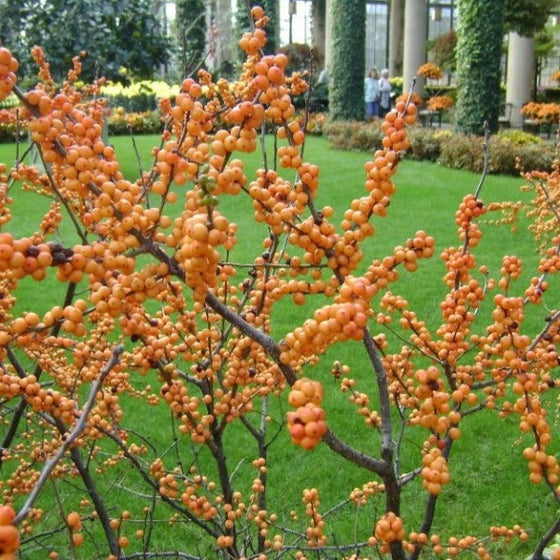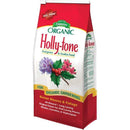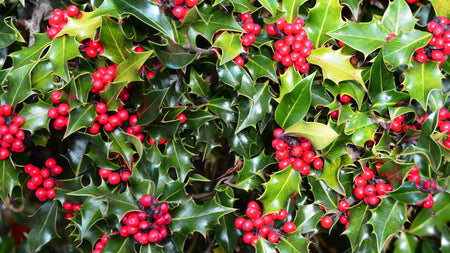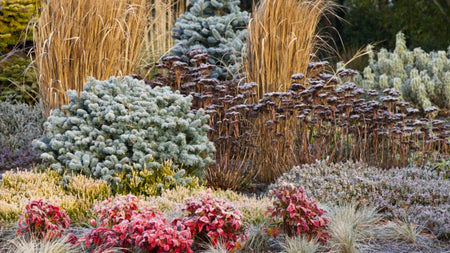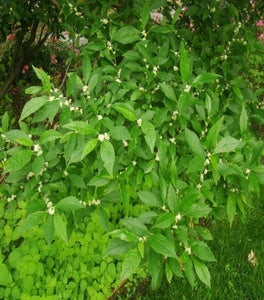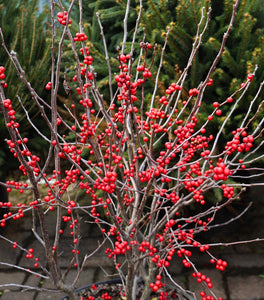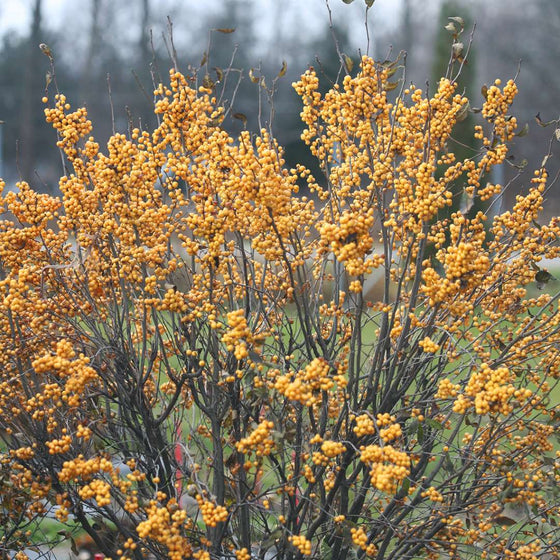
Images Depict Mature Plants
Winter Gold Winterberry Holly Shrubs for Sale Online
Winter Gold Winterberry Holly (Ilex verticillata 'Winter Gold') is a stunning deciduous shrub renowned for its clusters of soft, golden-orange berries that persist well into winter, bringing a unique and warm touch to the cold season landscape. Unlike the traditional red winterberry varieties, Winter Gold offers a distinct visual contrast with its golden berries, which stand out beautifully against a backdrop of bare branches or snow. Reaching a mature height of 6 to 8 feet and a spread of 6 to 8 feet, Winter Gold is perfect for use in mixed borders, as a striking hedge, or as a specimen plant in the landscape. This winterberry thrives in full sun to partial shade and prefers moist, slightly acidic soils, making it ideal for low-lying areas, rain gardens, and naturalized planting zones.
Winter Gold Winterberry Holly requires a compatible male pollinator planted nearby to ensure the best berry production. The recommended male pollinator for Winter Gold is Southern Gentleman Winterberry Holly (Ilex verticillata 'Southern Gentleman'). Southern Gentleman blooms at the same time as Winter Gold, providing the essential pollen needed for the female flowers to develop into the signature golden berries. Plant Southern Gentleman within 30 to 50 feet of Winter Gold to allow effective pollination by wind or insects. Without a male pollinator, Winter Gold will produce flowers but will not develop the beautiful golden berries that make it a standout feature in the winter landscape.
In addition to its stunning appearance, Winter Gold Winterberry Holly also serves an essential ecological role in supporting local wildlife. The berries, which remain on the shrub through late winter, provide an important food source for birds such as robins, cedar waxwings, and bluebirds, offering them sustenance when other natural food supplies are limited. Winter Gold's adaptability to wet soils and its tolerance to periodic flooding makes it an excellent choice for challenging garden spaces, including areas prone to excess moisture. With its unique golden berries, easy maintenance, and valuable role in attracting wildlife, Winter Gold Winterberry Holly is an exceptional addition to any garden seeking year-round interest and ecological benefits.

| Hardiness Zone: | 3-9 |
|---|---|
| Mature Height: | 6 to 8 Feet |
| Mature Width: | 6 to 8 Feet |
| Classification: | Deciduous shrub |
| Sunlight: | Full sun to part shade |
| Habit: | Deciduous, densely branched, shrub forming |
| Flower Color: | White but inconspicuous |
| Foliage: | New growth emerges a deep dark green, changing to a golden yellow in the fall |
| Soil Condition: | Any well drained soil but will tolerate “wet feet” |
| Water Requirements: | Water well until established |
| Uses: | Extremely attractive when used as a focal point in the mixed border, mass planting, or a specimen planting |
How to Care for Winter Gold Winterberry Holly
Before you buy an Winter Gold Winterberry Holly, make sure to read about the recommended care instructions to keep this plant healthy and thriving.
How Do I Plant Winter Gold Winterberry Holly Shrubs?
To plant Winter Gold Winterberry Holly shrubs, start by selecting a location that offers full sun to partial shade with moist, slightly acidic soil. This winterberry thrives in areas with good moisture retention and can handle wet or poorly drained conditions, making it suitable for rain gardens or low-lying parts of your landscape. Begin by digging a hole that is twice as wide and the same depth as the root ball. Place the shrub in the hole, ensuring the top of the root ball is level with the ground surface. Gently backfill with the excavated soil, firming it around the roots to eliminate air pockets, then water thoroughly to help the plant settle. This will promote good contact between the roots and the soil, ensuring a strong start for your Winter Gold Winterberry. After planting, apply a 2-3 inch layer of organic mulch around the base of the shrub to help retain soil moisture, moderate temperature, and suppress weeds. Keep the mulch a few inches away from the trunk to prevent rot and promote airflow. It’s also crucial to plant a compatible male pollinator, such as Southern Gentleman Winterberry Holly, within 30 to 50 feet of the female Winter Gold to ensure successful pollination and berry production. Proper spacing will allow the male shrub to provide the pollen needed for the bright golden berries to form. Water regularly during the first year, especially during dry spells, to help establish a robust root system. By following these planting steps, your Winter Gold Winterberry Holly will thrive, producing a beautiful display of unique golden berries that attract birds and brighten your winter garden.
How Do I Water Winter Gold Winterberry Holly Shrubs?
To properly water Winter Gold Winterberry Holly shrubs, it’s essential to maintain consistent soil moisture, especially during the first growing season to establish a strong root system. Water your Winter Gold deeply once or twice a week, depending on rainfall, ensuring the soil stays moist but not waterlogged. This winterberry variety is well-suited for wet or poorly drained soils, making it ideal for rain gardens, low-lying areas, or other spots where moisture tends to accumulate. However, it's important to avoid letting the shrub sit in standing water for prolonged periods to prevent root rot. A slow, deep watering method, such as a soaker hose, helps water reach the roots effectively, promoting healthy growth. After your Winter Gold Winterberry Holly is established, it will be more tolerant of temporary dry spells but will still benefit from regular watering during extended periods of hot or dry weather. Check the soil around the base of the shrub frequently—if the top few inches feel dry, it’s time to water. Adding a 2-3 inch layer of organic mulch around the shrub can help retain moisture, reduce evaporation, and regulate soil temperature, making it easier to maintain consistent moisture levels. Always water at the base of the plant to ensure the roots get the most benefit while minimizing the risk of leaf disease. Consistent watering will keep your Winter Gold Winterberry Holly healthy and vigorous, resulting in a lush plant covered in stunning golden berries that brighten your winter landscape.
How Do I Fertilize Winter Gold Winterberry Holly Shrubs?
To fertilize Winter Gold Winterberry Holly shrubs, apply a balanced, slow-release fertilizer in early spring just before new growth begins. A fertilizer with a formula like 10-10-10 or 12-6-6 will provide the essential nutrients needed for robust growth and prolific berry production. Spread the fertilizer evenly around the base of the shrub, making sure to keep it away from direct contact with the trunk to prevent root burn. Apply the fertilizer in a circle extending out to the drip line, which is the area beneath the outermost branches where the roots absorb the most nutrients. After fertilizing, water thoroughly to help dissolve the nutrients and ensure they reach the root system of your Winter Gold Winterberry Holly. It’s also beneficial to test your soil before fertilizing to determine its pH level, as Winter Gold Winterberry Holly prefers slightly acidic soil, ideally between 5.0 and 6.5. If your soil is too alkaline, consider adding elemental sulfur to lower the pH gradually, creating a more favorable growing environment for your winterberry. Additionally, organic fertilizers, such as compost or aged manure, can be used to supplement the soil with essential nutrients and improve overall soil health. Avoid over-fertilizing, as this can lead to excessive vegetative growth at the expense of flower and berry production. By providing the right nutrients, your Winter Gold Winterberry Holly will thrive and produce a stunning display of golden berries, adding unique beauty and ecological value to your winter garden.

How Do I Prune Winter Gold Winterberry Holly Shrubs?
To prune Winter Gold Winterberry Holly shrubs, the best time is in late winter or early spring before new growth starts. During this time, it’s easier to see the structure of the shrub and determine which branches need to be removed. Start by cutting away any dead, damaged, or diseased branches to promote the overall health of the plant. Additionally, remove any crossing or crowded branches to improve air circulation and sunlight penetration, which helps reduce the risk of disease and encourages more vigorous growth. Light pruning is recommended to maintain the natural shape of the shrub and ensure it remains attractive throughout the year. It’s important not to over-prune Winter Gold Winterberry Holly, as the berries form on the previous year’s growth. Heavy pruning could significantly reduce the number of flowers, and thus the number of berries produced. Aim to trim only what’s necessary to maintain the shrub’s shape and health, and focus on thinning out older branches to rejuvenate the plant when needed. To ensure successful berry production, plant a compatible male pollinator, such as Southern Gentleman Winterberry Holly, nearby. Pruning in this way will help your Winter Gold Winterberry remain healthy and allow it to produce its beautiful golden berries, which provide an eye-catching feature in your winter landscape and attract birds.

